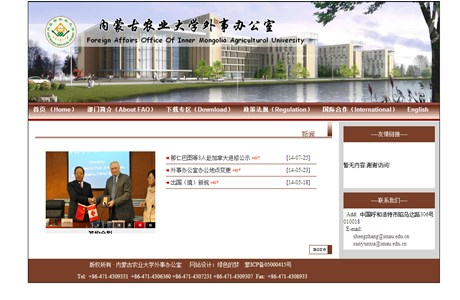Inner Mongolia Agricultural University

Inner Mongolia Agricultural University is a multi-disciplinary university located in Hohhot, the capital city of Inner Mongolia Autonomous Region, China.
In 1952, a seed was sown in the heart of Inner Mongolia with the establishment of a university dedicated to a critical cause - bolstering the region's agriculture and ecological understanding. This institution, with its initial focus firmly on these disciplines, embarked on a mission to revolutionize agricultural practices. Over the years, it grew from a specialized entity into a sprawling academic hub. The early decades witnessed a period of focused growth, laying the foundation for future diversification. The 1960s saw a name change to reflect a broader scope, encompassing both animal husbandry and agriculture. Finally, in 1999, a pivotal merger with the Inner Mongolia Forestry College solidified its position as a comprehensive university. This consolidation brought together expertise in forestry and agriculture, creating a powerhouse for research and education in these interconnected fields.
The university's journey hasn't been without its challenges. Adapting to a broader curriculum while maintaining its agricultural focus required strategic planning and resource allocation. Merging with another institution presented logistical hurdles, but the resulting synergy ultimately strengthened its academic offerings. Through these challenges, the university emerged as a more robust and adaptable institution.
Campus life at this university is a vibrant tapestry woven with academic pursuits, extracurricular activities, and a strong sense of community. Students from all walks of life come together to learn, explore, and forge lifelong friendships. A multitude of clubs and organizations cater to diverse interests, fostering a dynamic environment where students can discover their passions and develop their talents. Whether it's participating in debate teams, volunteering for social causes, or joining cultural groups, there's something for everyone. The university's motto, "Solidarity, factualism, erudition, innovation," serves as a guiding principle for both students and faculty. It emphasizes the importance of collaboration, a commitment to evidence-based knowledge, the pursuit of intellectual excellence, and the courage to break new ground. This motto inspires a culture of critical thinking, problem-solving, and a drive to push the boundaries of knowledge.
Looking towards the future, the university has ambitious plans to solidify its position as a leader in innovation and research. With a focus on sustainability and addressing global challenges, it aims to develop solutions for a better tomorrow. It aspires to nurture future generations of well-rounded individuals equipped with the knowledge, skills, and critical thinking necessary to tackle complex issues and contribute meaningfully to society. The university's unwavering commitment to academic excellence, coupled with its vibrant campus life and future-oriented vision, ensures it remains a beacon of learning and progress for years to come.
University Profile
Get a quick snapshot of the university's key details.
| University Name | Inner Mongolia Agricultural University |
|---|---|
| Name in Local Language | 内蒙古农业大学 |
| Acronym | IMAU |
| Year Established | 1958 |
Location
The university is located in Hohhot, Inner Mongolia Autonomous Region. Find the address of the university below.
| Address | 306 Zhaowu Dalu, Hohhot, Inner Mongolia Autonomous Region, China |
|---|
Contact
Connect with the university easily! Find their contact details.
| Phone | +86 (471) 4309294 |
|---|---|
| Fax | +86 (471) 4308933 |
| Website |

|
| Click here to send email | |
| More Links |
Admission Info
Find information below on admission to Inner Mongolia Agricultural University.
| Student Body | Men and Women |
|---|
Scholarship and Financial Aids
There is no information found on scholarships or financial aids offered by Inner Mongolia Agricultural University. You may like to visit their website for more details.
Programs and Courses
Get a quick overview of programs and courses offered at this university.
| Bachelor's Degrees | Master's Degrees | Doctorate Degrees | Diplomas | |
|---|---|---|---|---|
| Arts & Humanities | n/a | |||
| Business & Social Sciences | n/a | |||
| Engineering | n/a | |||
| Language & Cultural Studies | n/a | |||
| Medicine & Health | n/a | n/a | n/a | n/a |
| Science & Technology | n/a |
Click on the following button to explore a detailed list of programs and courses of this institute.
View Course ListRelated Articles
Stay informed with the following article related to the university or higher education in China.
